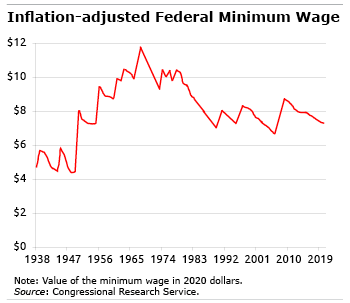
Federal Minimum Wage is 40% Below 1968
 Largely missing from the debate about raising the federal minimum wage is how much its value has eroded over the past 50 years.
Largely missing from the debate about raising the federal minimum wage is how much its value has eroded over the past 50 years.
The current federal minimum is $7.25 an hour. If the 1968 wage were converted to today’s dollars, it would be worth about $12 an hour.
At $7.25 an hour, a full-time worker earns just over $15,000 a year before taxes, which is less than the federal poverty standard for a family of two. The Biden administration has proposed more than doubling the federal minimum to $15 by 2025, and one proposal in Congress would begin indexing the minimum wage to general wages so it keeps up with inflation.
A $15 an hour minimum isn’t enough, said one sympathetic Florida contractor who voted in November to gradually increase the state’s mandatory minimum wage to $15. “I’d like to see some of the American people go out there and try to make a living and put a roof over their head and raise a family,” he told a reporter. “It’s literally impossible.”
 But small businesses say raising the minimum wage would increase their financial pressures at the worst time – during a pandemic. At least 100,000 U.S. small businesses closed last year as governments restricted public gatherings to suppress the virus, and the Congressional Budget Office (CBO) estimates a higher federal minimum could eliminate 1.4 million jobs.
But small businesses say raising the minimum wage would increase their financial pressures at the worst time – during a pandemic. At least 100,000 U.S. small businesses closed last year as governments restricted public gatherings to suppress the virus, and the Congressional Budget Office (CBO) estimates a higher federal minimum could eliminate 1.4 million jobs.
This evidence ignores the complexity of low-wage workers’ situations. Employee turnover is extremely common in low-wage jobs in fast food establishments, for example, and workers frequently have bouts of unemployment that further reduce their already low earning power. Raising the minimum wage could somewhat compensate for their spotty employment and provide more money for essential items. And while the CBO warns of job losses, it also predicts that a higher federal minimum wage would lift 900,000 million workers out of poverty.
Many states have approved incremental automatic annual increases, and a $15 minimum wage has been approved in eight states, including Florida. Voters – over the objections of the Florida Chamber of Commerce – approved raising the state’s minimum wage from $8.65 this year to $15 in 2026.
“We won’t get fifteen for another five years. We need that now,” an Orlando McDonald’s worker, Cristian Cardona, told The New Yorker.
Once again, inflation is a problem. “By the time we get fifteen, it’s going to be even less,” he said.
Read our blog posts in our ongoing coverage of COVID-19.
Squared Away writer Kim Blanton invites you to follow us on Twitter @SquaredAwayBC. To stay current on our blog, please join our free email list. You’ll receive just one email each week – with links to the two new posts for that week – when you sign up here. This blog is supported by the Center for Retirement Research at Boston College.
Comments are closed.







$15 an hour is very little and $7.25 is even less. Even my cat makes more. But we need to know why people are working in low paid jobs. If $7.25 an hour is simply the going rate, then an increase in the minimum wage will put them out of a job. But if low pay reflects inequality in bargaining power between employer and employee, then an increase in the minimum wage will not put people out of a job. The evidence suggests that in the short run, minimum wage hikes don’t put people out of a job. But in the long run, the story might be very different. Walmart may decide it no longer wants annoying greeters, warehouses may be automated, and Ubers replaced by flying cars.
This is a very interesting analysis. Too many times, inflation is unaccounted for in public policies. Another example is that the federal gas tax is not indexed to inflation, and the last time it increased was 1993.
It’s silly for anyone to look at that graph and say, “Jeez, I had no idea.” We have watched the national economy grow in such a way that more and more of that growth goes to those at the top of the income distribution. Well, guess what? In that case, less and less goes to those at the bottom of the income distribution. We can talk about growing the pie, but when we also change how it’s cut…
The richest nation the world has ever known and the guarantee is 7.25 per hour.
I’m not sure Oklahoma and Mississippi should have the same minimum wage as California and New York. Why doesn’t Congress take into account different cost-of-living between the states?
No one is expected to support a family on minimum wage.
Wages are defined by the skill set of the employee as well as the contribution of that employee’s portion to the end product. The skillset of an employee at a fast food restaurant is low, thus a low wage as they’re enhancing their skillset and learning about business, customer service, etc. No one intended these entry level jobs to raise a family on or to maintain a decent living in. (I was a stock clerk in a department store right out of high school; full-time; minimum wage. I understand what it’s like.)
The fast food restaurant employee who works smart will get the promotions, get the higher and higher wage that is commensurate with his/her skill set. (Or will move to another occupation where the salary is commensurate to whatever skillset he/she wants to attain.) That provides opportunities for another low/unskilled person to move into an entry level position to learn new skills, business acumen, customer service, etc.
This cycle works, and the wages are always tied to the work the person is doing and the contribution they’re making in regards to the end product or service.
“(I was a stock clerk in a department store right out of high school; full-time; minimum wage. I understand what it’s like.)” Look again at the graph. I’m guessing you don’t.
Lesson learned for me back then, that minimum wage was not intended for a family to live on. (Not even as a single person with no kids like I was.)
The graph demonstrates that even more so today. Leave the minimum wage jobs for the young, low skillset kids (like I was) who need to learn and gain business acumen. Everyone needs to strive and gain the skillsets to move above that.
Might be interesting to compare the ratio of minimum wage to median wage, then and now.